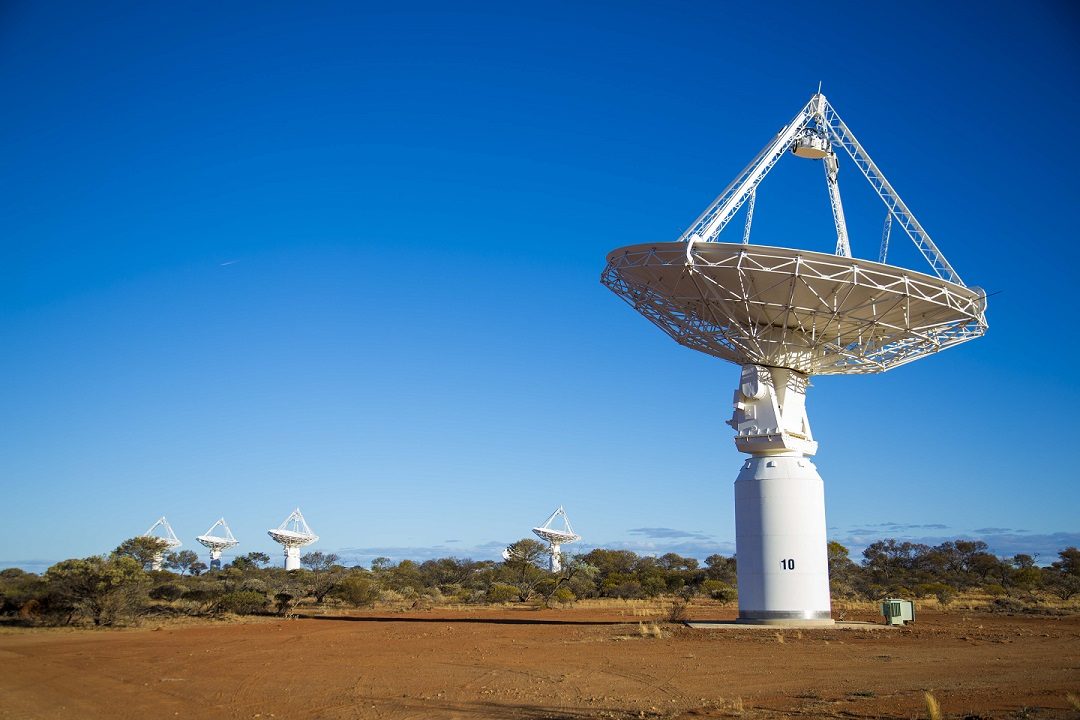A new study reports the detection of 19 previously undiscovered FRBs, including the closest one to Earth and the brightest one ever seen. The results boost the total tally significantly; just three dozen or so FRBs had been known previously, with the first detection coming in 2007.
FRBs are brief (millisecond-long) but intense emissions of radio light, which can pack as much energy as our own sun produces over the course of nearly a century. Their source is the topic of much discussion and debate. For example, some researchers have suggested that FRBs could be generated by advanced alien civilizations, though most astronomers favor natural explanations, such as fast-spinning neutron stars.
The new study is led by Ryan Shannon, of the Swinburne University of Technology in Australia. Since the beginning of 2017, he and his team have been searching the skies for FRBs using the Australian Square Kilometer Array Pathfinder (ASKAP), a network of 36 radio dishes in Western Australia.
The systematic hunt has already turned up 20 FRBs, the researchers report in the new paper, which was published online today (Oct. 10) in the journal Nature. (One of the bursts they spotted was reported previously in a different paper, so the count of newfound FRBs technically stands at 19.)
The team's success rate can be traced to two factors, said study co-author Keith Bannister of the Commonwealth Scientific and Industrial Research Organization (CSIRO), Australia's national science agency, which designed and engineered ASKAP.
"The telescope has a whopping field of view of 30 square degrees, 100 times larger than the full moon," Bannister said in a statement.
"And, by using the telescope's dish antennas in a radical way, with each pointing at a different part of the sky, we observed 240 square degrees all at once - about 1,000 times the area of the full moon," he added."ASKAP is astoundingly good for this work."
The team's analyses show "that fast radio bursts are coming from the other side of the universe rather than from our own galactic neighborhood," Shannon added in the same statement.
The researchers did turn up the nearest known FRB to Earth - an event known as FRB 171020, which originated about 425 million light-years away from our planet. That's about twice as close as the previous record holder, Shannon told Space.com.
And the ASKAP survey has discovered the most powerful FRB known - again, by a factor of two, said Shannon, who's also affiliated with the Australian Research Council Centre of Excellence for Gravitational Wave Discovery (OzGrav).
None of the newly detected FRBs was seen to flash more than once over the study period, even though the team observed FRB-harboring fields repeatedly and spent more than 12,000 hours following up FRB finds, Shannon said.
Indeed, to date, just one "repeater" has been confirmed - a source called FRB 121102, which has fired off bursts multiple times since its 2012 discovery, including a barrage of at least 93 over the course of a single day in August 2017.
The odd example of FRB 121102 and the new results raise an important question, Shannon said: "Are there two classes of FRB sources? The differences between the repeater and the others are becoming too hard to ignore."
There's another important implication of the new study as well, he added. The ASKAP FRBs are brighter than previous detections, and they feature lower "dispersion." Dispersion refers to the spreading or smearing of the different wavelengths that make up a burst - basically, how much these various wavelengths have been slowed by intervening material on their way from the FRB source to Earth.
"The fact that there is a relationship between brightness and dispersion tells us that the material that is producing the dispersion is outside of galaxies, in the faint tenuous gas in the intergalactic medium," Shannon told Space.com via email. "This means that we can use FRBs to study this material, which is nearly impossible to observe using other techniques (optical, X-ray observations, for example)."
In the future, Shannon and his colleagues aim to nail down the location of the FRBs further. They should be able to tie each burst to its home galaxy, the researchers said.
As its name indicates, ASKAP is a pathfinder for the Square Kilometer Array (SKA), a huge network of radio dishes across Australia and South Africa that's scheduled to start taking shape over the next few years. The SKA may end up finding many more FRBs, study team members said.
Mike Wall's book about the search for alien life, Out There,will be published on Nov. 13 by Grand Central Publishing. Follow him on Twitter @michaeldwall. Follow us @Spacedotcom or Facebook. Originally published on Space.com.




Comment: Further reading